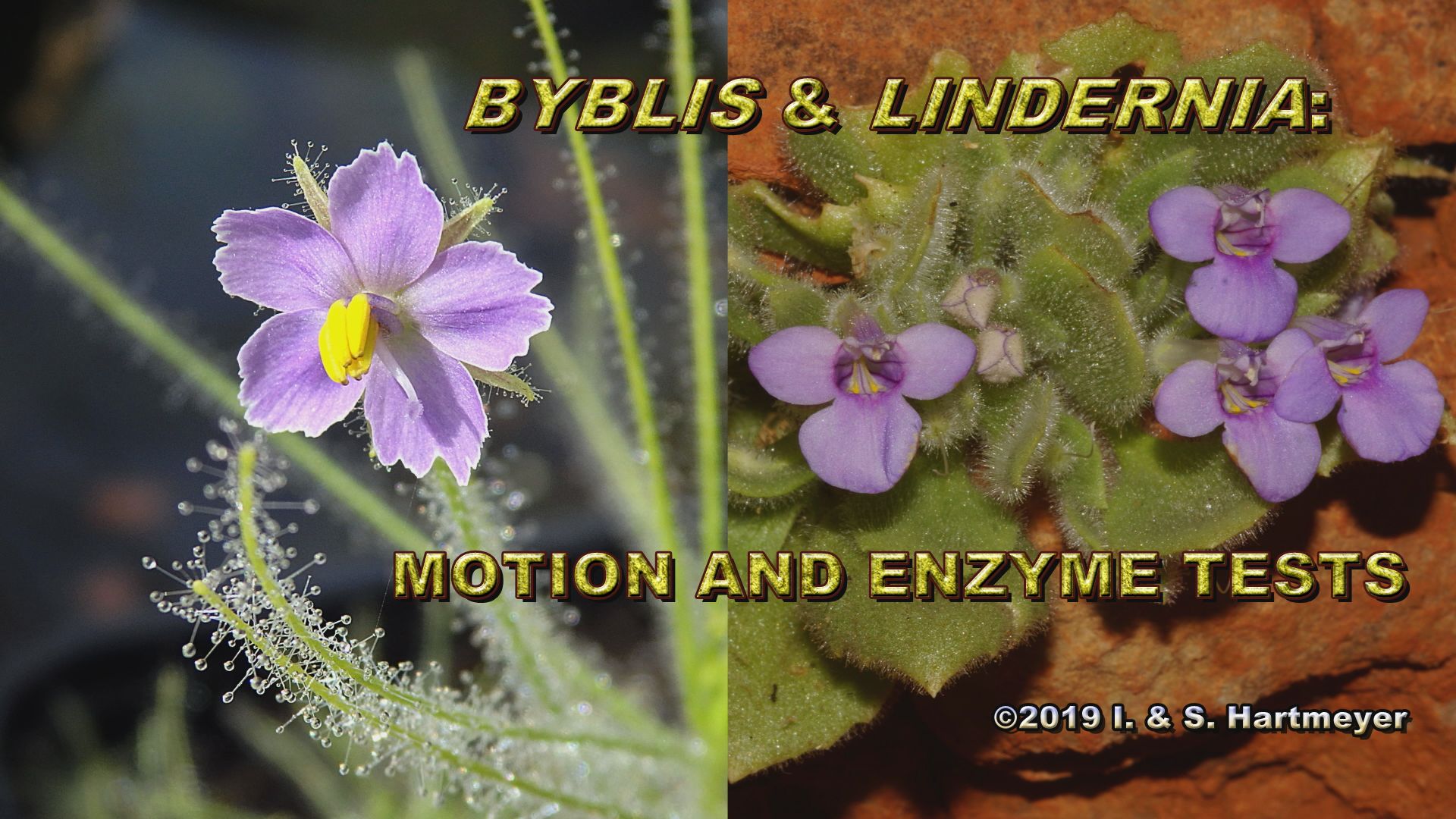|
 Observations and tests on cultivated tropical Byblis Observations and tests on cultivated tropical Byblis
Siegfried R. H. Hartmeyer and Irmgard Hartmeyer (2019). Carnivorous Plant Newsletter Vol. 48/2: 74-78.
Keywords: Byblis, cultivation, hybridization, enzyme test, trichome motion.
Jetzt verfügbar / now available: Der vollständige Text / Full text (PDF)
|
Introduction
The annual Byblis species (Byblidaceae, Lamiales) are predominantly Australian endemics with B. liniflora
extending also north to Papua New Guinea (Cross et al. 2018). Beside
their features as sticky carnivorous plants, many enthusiasts
especially appreciate their bushy appearance with many showy
hermaphroditic flowers. The following report features our experiences
with the cultivation and hybridization of B. filifolia and B. liniflora over two decades at our heated greenhouse in Weil am Rhein (Germany).
Deutsche Übersetzung:
Die einjährigen Byblisarten (Byblidaceae, Lamiales) sind
hauptsächlich australische Endemiten, bis auf B. liniflora, die auch
weiter nördlich bis Papua Neuguinea vorkommen (Cross et al. 2018). Neben
ihren Eigenschaften als klebrige Karnivoren, sind sie bei vielen
Sammlern wegen ihrer buschigen Erscheinung mit zahlreichen prächtigen
zwittrigen Blüten beliebt. Der folgende Artikel zeigt unsere Erfahrungen
mit der Kultur in unserem beheizten Gewächshaus in Weil am Rhein sowie mit die Hybridisierung von B. filifolia und B. liniflora.
|
Excerpt:
 Figure 3: Anthers and stigma of a self-pollinating B. liniflora (left). B. filifolia seedpod with ripening hybrid seeds (center).
Figure 3: Anthers and stigma of a self-pollinating B. liniflora (left). B. filifolia seedpod with ripening hybrid seeds (center).
B. filifolia x liniflora F1-seeds (right).
We produced a documentary film for YouTube, to accompany the article regarding the trichome motion..
Just click on the pictures to view the films on YouTube:

|
References
Allan, G. 2019. Evidence of motile traps in Byblis. Carniv. Pl. Newslett. 48: 51-63.
Barnes, B. 2009. Byblis ‘Goliath’. Carniv. Pl. Newslett. 38: 16-18.
Darwin, C. 1875. Insectivorous Plants. John Murray, London.
Cross, A.T., Paniw, M., Scatigna, A.V., Kalfas, N., Anderson, B., Givnish, T.J., and Fleischmann,
A. 2018. Systematics and evolution of small genera of carnivorous plants. In: Ellison, A.M.,
& Adamec, L. (eds.). Carnivorous Plants: Physiology, Ecology, and Evolution. pp. 120-134.
Oxford University Press.
Hartmeyer, I., and Hartmeyer, S.R.H. 2005. Byblis filifolia als echte Karnivore rehabilitiert. Das
Taublatt 2005/3: 04-05.
Hartmeyer, I., and Hartmeyer, S.R.H. 2008. “Enjoy Your Meal Part 2: Enzyme-testing with Byblis,
Drosera and Roridula”. https://www.youtube.com/watch?v=ebJzWk-duiM
Hartmeyer, I., and Hartmeyer, S.R.H. 2010. “Pulvinus and Movement in Byblis”. https://www.youtube.
com/watch?v=cESW11j6SrM
Hartmeyer, I., and Hartmeyer, S.R.H. 2011. Comparison of Byblis ‘Goliath’ (B. filifolia), Byblis
‘David’ (B. liniflora), and their putative fertile hybrid. Carniv. Pl. Newslett. 40: 129-135.
Hartmeyer, I., and Hartmeyer, S.R.H. 2018. “Byblis and Lindernia: Motion and enzyme tests”.
https://youtu.be/2hoUCQjf2LE
Hartmeyer, S.R.H. 1997. Carnivory in Byblis liniflora revisited (I): A simple method for enzyme
testing on carnivorous plants. Carniv. Pl. Newslett. 26: 39-45.
Lloyd, F.E. 1942. The Carnivorous Plants. Chronica Botanica, Waltham.
|
|

